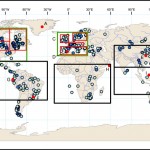During the Holocene, the last 11,000 years, climate, vegetation, and likely, humans have been key controls to changing fire regimes in the Americas. A long-accepted paradigm is that of the ‘noble savage’, whereby indigenous peoples lived in harmony within a pristine wilderness, with little or no significant impact upon natural ecosystems. However, increasing evidence for extensive, large-scale landscape modification is leading many archaeologists to argue that the very notion of ‘virgin’ forests is a myth, and that prior to the Spanish Conquest, forests, grasslands, and savannas were heavily managed using fire, transforming a once pristine wilderness into a ‘cultural parkland’ (Heckenberger et al. 2003). According to this theory, the ‘pristine wilderness’ first encountered by Europeans was in fact secondary forest recovering after the catastrophic crash in indigenous populations caused by first exposure to European diseases that swept through the Americas in advance of European settlers (Mann, 2006). If true, then fire frequencies would be expected to be significantly lower in the 16 and 17th centuries compared with the 15th century. We aim to test this hypothesis using data from the recently created Global Charcoal Database, analyzing charcoal data from throughout the Americas.

